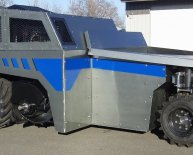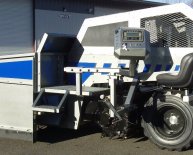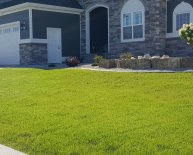
Used curb Machines
These optional attachments can increase the versatility of a mold and eliminate the need for additional molds. But, in many cases, it is quicker to exchange molds than to install or remove an attachment. In the long run, multiple single purpose molds may have more overall benefit. Contact the Power Curbers Mold Department, your Regional Manager, or authorized dealer to discuss your applications and for help with choosing mold options.
For proper fit and function, the mold must be cleaned before installing bolt-in attachments. If wanted on a mold, these options must be shown or noted on the approval drawing.
Block-Out – A block-out is used to change the pouring width of a mold. It is generally bolted into the gutter section of the mold, but can be used to remove a feature such as a step on the back of the curb which supports a sidewalk.
While the pouring width is reduced with a block-out, the overall width of the mold remains the same. Site preparation must be done to accommodate the full width of the mold.
Safety should be observed as a block-out will have a sharp edge, where its shell intersects with the mold shell.
Bolt-On Extension – A bolt-on extension increases the pouring height of a mold and is typically used in pairs. They attach to the bottom of the mold, so the increased height is in the base; it does not change the height of the curb face.
A mold may have multiple extensions for pouring different heights. In some cases, extensions may be stacked to result in a different height (and reduce the overall number of extensions needed). As the height of the extension increases, they are more likely to deflect, due to the pressure of the vibrated concrete against them.
Extensions are generally interchangeable between molds designed to accept them. If a mold is to be built to accept bolt-on extensions included with another mold, the drawing must reflect this.
Detachable Toe – A detachable toe can be removed in order to place the gutter adjacent to existing pavement. But, when bolted in place, the same mold can pour stand-alone curb and gutter.
Difficulty with radii is one of the limitations of working adjacent to existing pavement. Excessive material waste and/or improper filling of the mold can result. Also, the mold shell should not be allowed to overlap the existing pavement. Doing so may allow material to build up under the shell and cause it to lift.
Molds with a detachable toe are built without our normal adjustable screed. Vent slots are used to compensate for the absence of the screed. Taller toes, when in place, may deflect, due to the pressure of the vibrated concrete against them. Detachable toes are not designed to be installed in a different location as a replacement for a block-out (except on sidewalk molds).
Driveway Knife – A driveway knife is used to reduce labor and wasted material at driveway entrances. When engaged, it prevents material from filling the curb portion of the mold.
Our standard type utilizes a rotating plate through a slot in the mold shell to block the flow of concrete. It will not finish the surface, but eliminates the need to remove the material by hand. It is common to position the knife so it leaves material for the finishers to complete the entrance.
Driveway Knife, Side Entry Style – This is a sliding plate that enters the curb portion of the mold from the side and is formed to create a slight choke. The side to side slope is normally flat. The side entry design provides a better, but not perfect, finish at driveways. The transitions from curb to driveway still require forming and finishing by hand.
The slope of the gutter may be such that the side-entry style cannot be used. Each mold must be individually analyzed to determine its compatibility. Other mold options may not be compatible with a side-entry knife. This design requires disassembly and cleaning after each use of the mold.
Hand Mule – This is a hand tool for finishing work. In terminology used by Power Curbers, the form that attaches to the machine is referred to as a mold. Some people interchange the terms mule and mold.
Outflow Plate – An outflow plate, when bolted in place, changes a mold with a catch gutter into a spill gutter by reducing the height of the toe. If a reduction in the toe height is not acceptable, an outflow plate can be combined with a bolt-on extension to restore the correct toe height. (See Bolt-On Extension.)
Porched Open Front – When pouring over reinforcing steel, the front of a mold must be open to allow the steel to pass through. A “porch” surrounds the opening and extends forward in order to contain the concrete that escapes through the opening. This is common on molds for bridge parapets, barriers, and is sometimes used in curbs, sidewalks, or other applications. (Note: The trimmer cannot be used when steel is present and must be shifted completely out of the way!)
Generally, the porch is designed integral to the mold, but may be designed as removable. Due to possible interference with the trimmer and difficulty when pouring down hill, a mold with an open front should not be used unless reinforcing steel is present. A porched open front may be used in conjunction with an open toe to allow the mold to operate over tie bars extending from existing pavement. (See Detachable Toe.) Extreme care must be used when pouring a radius over steel as interference with the mold may result.

















